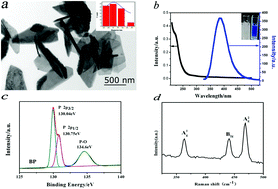Electrogenerated chemiluminescence of black phosphorus nanosheets and its application in the detection of H2O2
Abstract
Black phosphorus nanosheets (BPNS) were synthesized from BP crystals through liquid exfoliation coupled with ultrasonic methods under aqueous conditions. The morphology of the synthesized BPNS was characterized by TEM, XPS, AFM, Raman spectroscopy, UV-vis absorption and fluorescence spectroscopy, respectively. The obtained BPNS exhibited a multilayer structure and the lateral length was around 300 nm, and could emit fluorescence at 380 nm. A BPNS modified glassy carbon electrode (BPNS/GCE) was fabricated and a strong anodic electrogenerated chemiluminescence (ECL) signal was obtained at the modified electrode with tripropylamine (TPrA) as a coreactant under neutral conditions. Hydrogen peroxide exhibited an apparent inhibiting effect on the anodic ECL signal, and can be sensitively detected. In the range of 1–1000 nM, the decreased ECL intensities varied linearly with the logarithm of the H2O2 concentration, and the detection limit was calculated as 0.96 nM (3σ). The proposed modified electrode exhibited high sensitivity and good stability. The results revealed a new character of BPNS in ECL investigation, and the potential application of 2D nanocomposites in the ECL sensing field.

- This article is part of the themed collection: Optical Biosensor Devices


 Please wait while we load your content...
Please wait while we load your content...